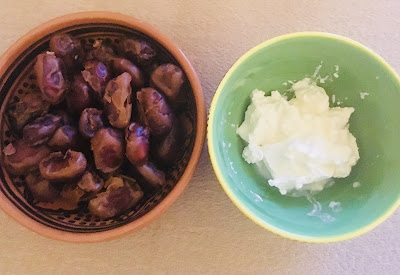Qatar's deserts burst into flower
Qatar has seen an unusual period of sustained rainfall in the last week or so. Some say they haven't experienced rain like it for 20 years. It wasn't particularly heavy but it rained on and off for an entire week, causing flooding and standing water across the country and turning areas of desert into lakes and swamps.
Having heard about the potential for a treasure chest of blooms locked beneath the sand, to burst through after heavy or prolonged rainfall, we decided to go on a desert flower hunt.
In the pouring rain, we set off west towards Umm Bab - which means "mother gateway", referring to two small hills either side of an opening giving the appearance of a gateway. Its a small coastal town built to accommodate the workers of Qatar Petroleum in 1948.
When we arrived at Umm Bab beach, a beautiful oasis of palm trees and low lying shrubs, the sun mysteriously came out and the rain stopped! The guys playing football there were pretty happy about that too!
We wandered off in search of the illusive desert flowers we'd heard so much about, not exactly expecting what we were about to find. We soon stumbled across a cluster of Desert Thumbs.... latin name 'Cynomorium coccineum', growing to 6 -12 inches.
This parasitic perennial apparently has a use in both Arabic and Chinese herbal medicine. Known locally as Tartuth and long eaten by the bedouin on camel treks across the desert, it is thought to have therapeutic properties beneficial for blood disorders, reproductive problems and digestive ailments. Studies in China have established evidence of strong anti-oxidant properties.
Bedouin women also used the red pigment as a fabric dye. The plant would have been harvested after the rains and sold in large numbers in the souq.
Close to this cluster, we then spotted the striking colours of the desert hyacinth (Cistanche tubulosa). These appeared randomly in ones, twos or threes.
Another parasitic plant, it obtains its nutrients and water from the roots of other plants, which explains why we most often found them embedded in low level shrubs. It had a very firm, fleshy, almost rubbery feel to it and one could imagine it withstanding the most vicious of sandstorms!
Recent Chinese studies have concluded that the desert hyacinth contains a substance which can help to regulate the blood glucose level and can help in the treatment of both type 1 and 2 diabetes. But the Bedouin would dry it and mix the powder with camel milk to treat injuries and boil the stem to treat diarrhoea.


Other flowers we came across included a yellow flower, Launaea Mucronata, a member of the dandelion family
and numerous low level shrubs including Zygophyllum Qatarense, which grows in a salty environment and has small fleshy leaves which retain moisture. This plant is said to be fed to camels at the beginning of the racing season, to purge them of toxins in their system.
And of course, the whole area dotted with date palms and beneath the clusters of trees, carpets of date seeds littered the ground...















Great Info!!! Thanks for sharing information with us. If someone wants to know about florist app development I think this is the right place for you.
ReplyDeleteThanks for sharing, nice post! Post really provice useful information!
ReplyDeleteAn Thái Sơn chia sẻ trẻ sơ sinh nằm nôi điện có tốt không hay võng điện có tốt không và giải đáp cục điện đưa võng giá bao nhiêu cũng như mua máy đưa võng ở tphcm địa chỉ ở đâu uy tín.